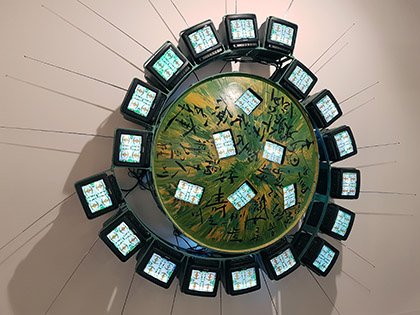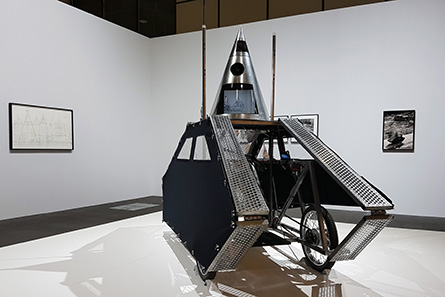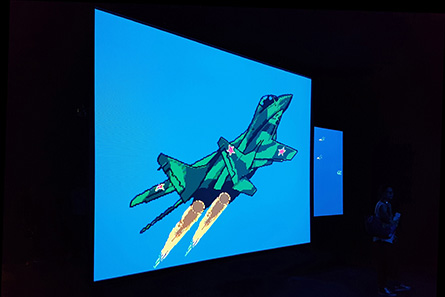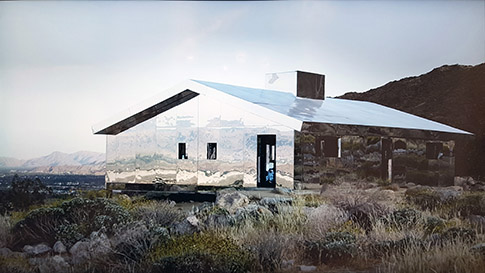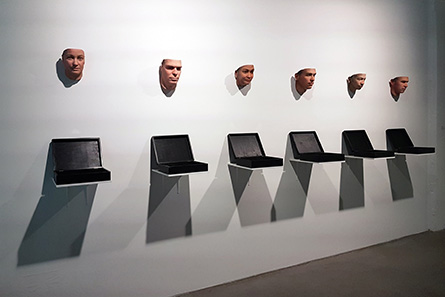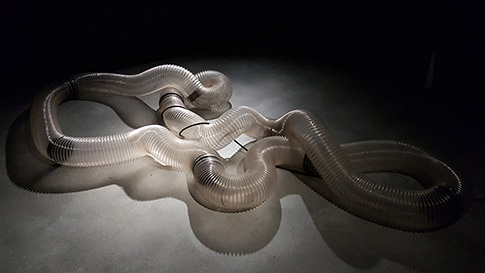ART BASEL 2017
by Dominique Moulon [ June 2017 ]
Mid-June, the principal players of the contemporary art world gather for Basel's fair and other events in as well as off or even out. Pulling out of the market allows us to walk around a few institutions such as the Haus der Elektronischen Künste.

The pioneers
Nam Jun Paik,
“Venus”, 1990.
 T
There still are, in the art market, large-sized works of Nam Jun Paik as at the booth of the
Hans Mayer gallery from Düsseldorf. Rightly considered as one of the pioneers of video art, this one started as early as the 1960s by drawing with light, by approaching magnets to cathode ray tube television sets without any program. Then, over the following decades, he assembled these kinds of TV sets, as it is the case with "Venus" at the Hans Mayer booth. Because the sculpture representing the telluric planet is literally encircled by portable televisions. On the twenty-four Sony TVs, a single program produces resolutely hypnotizing effects. The flow prevails over the images; we want to ignore the sources or messages. We are under the control of this flow without knowing how to get out of it. The same situation than that of the planet which, from a distance, seems to become distorted with the to-and-fro movements of translations, rotations and images scales. As long as what is repeated on the screens confers a real unity to this video sculpture while giving rhythm to it and altering it.

Politics in art
Krzysztof Wodiczko,
“Poliscar Variant 2”,
1991-2017.
 C
Concerning works of which the size exceeds that of the gallery booths, there is the Unlimited exhibition. It is precisely here that we discover the "Poliscar" conceived by Krzysztof Wodiczko in 1991 with its very recent reproduction by the
Lelong gallery in New York. The vehicle, of which the shapes are retro-futuristic, is surrounded by the technical drawings that preceded its initial production. And, although the artist studied industrial design in the Academy of Fine Arts in Warsaw, it is not a concept car. But it is rather a somewhat timeless concept and which must become part of the urban space to incite us to reconsider the homeless that the artist sees as " the true public of the city in that they literally live on the street." Moreover, the vehicle that is dedicated to them is equipped with a television transmission system highlighting the inherent contradiction to their existences. Because " while they are physically confined to public spaces they are politically excluded from public space," says Krzysztof Wodiczko who, since he began, makes art out of politics by using the media of his time.

Video game
Cory Arcangel,
“MIG 29 Soviet Fighter
Plane and Clouds”,
2005.
 T
The
Team gallery of New York, and
Lisson of London partnered up with each other to display a video installation of
Cory Arcangel. It is an extremely modified game like the artist did during the first half of the 2000s. Originally, there is a "MiG-29: Soviet Fighter," a shoot'em up of the beginning of the 1990s in which we play a Russian fighter plane evoking the Cold War. But the artist only preserved a little number of images of it, isolating them from the rest of the game; images from the plane and the clouds here and there. In this way, the game, losing its playability, shows its decontextualisation. This work could be presented from the players of computers, which would not make any sense for this artist who emerged by hacking Nintendo video games while offering the public the information and the means needed to do it, throughout his website. The shapes, in Cory Arcangel's work, are similar to pop art while the processes are more about the open source cultures, and more generally about sharing. This does not prevent him from being invested in the contemporary art market.

Artificial intelligence
Ian Cheng,
“Something
Thinking of You”,
2015.
 T
The aesthetics of the video game are also present at the booth of the
Standard gallery of Oslo, where the public can follow, in real time, the wanderings of what could be, according to the artist
Ian Cheng, "an animal, a plant, a tamagotchi, a pet, for you," knowing that it is "something which thinks about us" is autonomous. It seems, if it wasn’t computed by the machine, that it would be living its life. So here it is a matter of simulation of the living, and there are some former cases in this field. We inevitably think about the research from the mid-1990s done by Karl Sims staging "Evolved Virtual Creatures." But in twenty years, it is more computers, which, in our ecosystems, have singularly evolved while the video game industry has focused on simulation of the living as well as on artificial intelligence. Let us go back to Ian Cheng's work entitled "Something Thinking of You." It is the idea that this thing appearing to adapt particularly to its natural environment thinks about us that intrigues us. Unless it is the opposite, when we project ourselves into this "thing" to place some emotions in it such as fear when it seems to be hiding under a stone.

Special effects
Doug Aitken,
“Mirage”, 2017,
courtesy
303 Gallery,
New York.
 T
There are, in the cinema industry, two kinds of effects that we qualify as special when they are set up in the real in advance of the shooting, and as visual when they are computed by the machines during the post-production phase. The ranch-style house constructed in the Palm Springs desert by
Doug Aitken would belong to the category of the special effects, as it is in harmony with the landscape like a "mirage". We have the duty to mention Frank Lloyd Wright who popularized its style and whom we know was attached to integrating architectural features to the landscape. And we think of Alfred Hitchcock, who shot inside Fallingwater, when we discover the video sequence where Doug Aitken wanders into its resolutely sculptural gesture. Nothing of this ephemeral work will remain but the images, as it is appropriate in land art, because it is in a context of land art that it emerged. It is precisely with its video documentation, that this artwork enters the art market before its own destruction.

Art, science and genetics
Heather Dewey-Hagborg,
“Stranger Visions”,2012-2013.
 G
Going to the
Haus der Elektronischen Künste during
Art Basel means stepping back to observe the world differently. Where the artists like
Heather Dewey-Hagborg gets mixed up with whistleblowers. She started by doing an investigation in the streets of Brooklyn, collecting evidence from cigarette butts to used chewing gum to extract DNA from them. In order to, after that, prototype the faces of the unknown persons she tracked. Six of these simulations in three dimensions make up the artwork entitled "Stranger Visions". And it is above open suitcases symbolizing our genetic baggage that they are displayed. They allow us to visualize the information gathered through the dates, places and samples. Indeed, we do not know what the prints of our movements could, one day, say or betray our intimacy. However, is it not the duty of the artists and philosophers, more than the scientists, legal experts or politicians, to warn us about future possible misuses?

Breath of life
Cod.Act,
“π Ton/2”,
2017.
 W
Why go to Basel in June when, during the year, artworks that are presented there are also available through the Internet services like Artsy, Youtube, Instagram, Pinterest? Except if it is to discover artworks so recent that they have not yet left any traces on social media and, maybe, to live and share the experiences of it. As it is the case in the gathering of pipes entitled “π Ton/2” of the Swiss brother duo
Cod.Act: André and Michel Décosterd. When the movements that animate it literally give life to it and that we find ourselves trapped in the corner of the room, performing some gestures dictated by fear. Indeed, the artwork, as it is mentioned in its title, evokes engineering sciences and represents a python. And it is threatening in its convolutions, which we can only feel in its true presence. Not forgetting the sounds it generates and that adds to the suspense, to the tension that takes place in this dark room of the Haus der Elektronischen Künste.

Written by Dominique Moulon for ETC MEDIA and translated by Garance Moulon, June 2017.
